Art History
| Site: | Joans-place |
| Course: | Art |
| Book: | Art History |
| Printed by: | Guest user |
| Date: | Saturday, 25 October 2025, 9:09 AM |
Description
A look to the past guides in the future.
Introduction
We learn many things by just getting in there and doing it, and that is admirable. It is good, however, to sometimes take a look at how others have done what we are attempting. It is in this context that we will take a look at the history of art. We will take a linear approach to the history of art including many well known Artists. Art appreciation is by nature compromising and subjective and hopefully this next section of the course will help you refine your personal taste in art.The following lessons will give you a whirlwind tour through the great moments in art history.
An excellent site for art history:
http://smarthistory.org
Copyright information: Unaltered images or text from the Metropolitan Museum's Web site may be put on a file server at my school. There must be no charge for the user and electronic distribution is of limited term to your school. The images must remain unaltered and the citation should include the URL "www.metmuseum.org"
Prehistoric to Roman Times
30,000 to 10,000 BCDuring the Paleolithic Period or Old Stone Age, cave paintings, like the one from the Cave of Lasaux in France, and small sculptures like Venus of Willendorf c30,0000 - 25,000 B.C.. (a limestone fertility drawing of a woman with exaggerated bits) begin popping up in places like present day France and Spain
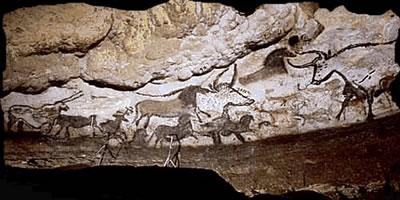 |
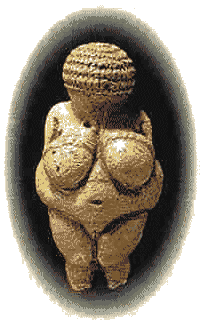 |
| Cave of Lascaux |
Venus of Willendorf |
10,000 to 8,000 BC
The Mesolithic Period Middle Stone Age sees people begin to settle in pseudo-farming communities. Cliff faces become canvases as people who are driven by thoughts of magic and hunting paint with dirt and animal fat.The paintings at Castellon are located in a rocky gorge.
 |
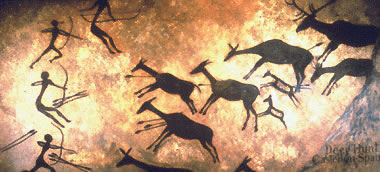 |
| Hand Prints Castellon, Spain |
Deer Hunt Castellon, Spain |
8,000 to 3,000 BC
As the New Stone Age or the Neolithic Period arrives; folks are living in village-like settings. they grow things and keep animals within their sight as simple architectural structures are built and richly decorated pottery is created. Stonehenge and other megaliths (big things) are constructed in what is now England and Scotland. Prehistoric art continues in various parts of the globe including North and South America.
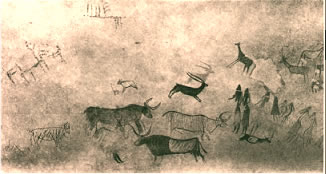 |
 |

|
| Women and Animals Facsimilie Cogul, Lerida, Spain c. 4000-3000 BC (BCE) Museo Arqueologico, Barcelona |
Tomb Interior with Corbeling and Engraved Stones Newgrange, Ireland c. 3000 - 2500 BC (BCE) |
Stonehenge, Salisbury Plain Wilshire, England c. 2750-1500 BC (BCE) |
3,000 to 331 BC
In Mesopotamia (roughly between present day Iran and Turkey) people construct ziggurats (palaces) as bronze sculptures, rock carvings and wooden musical instruments adorned with gold are created. Sumerians, Assyrians and Persians leave their artistic mark as they float in and out of the area.
 |
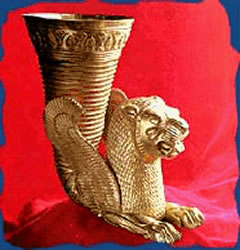 |
 |
3.200 to 1070 BC
In the land we call Egypt, people with a strong belief in the afterlife create paintings and elaborate sculptures to decorate tombs. The Great Sphinx is constructed from sandstone while limestone forms the base of the pyramid and temples.
 |
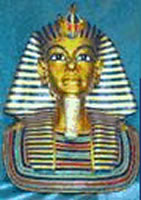 |
3,000 to 1,000 BC
The Minoans on the Island of Crete and the Mycenaeans of Greece create what we now call Aegean art. Gorgeous wall murals, and dazzling ceramic ware are created in between natural disasters and wars.
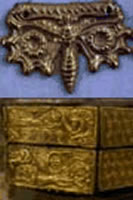 |
 |
| Minoan |
Mycenaean - the chanting priest |
800 to 323 BC
After creating simplified kouros (male) and kore (female) figures, the Greeks go wild portraying perfectly proportioned bodies of young men and women. The Parthenon is built, columns have personality and vase painting flourishes.
 |
 |
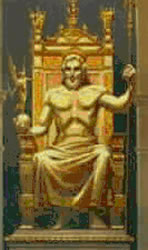 |
| The Discus Thrower |
Venus de Milo |
Zeus |
323 to 150 BC
The Hellenistic Period begins when Alexander the Great expires and his empire is liquefied. the art of this time is symbolic of the breakdown as pain, suffering, ecstasy and some other emotions are expressed. Later the Etruscans fabricate pottery and sculpture as funerary offerings- not unlike the Egyptians.
 |
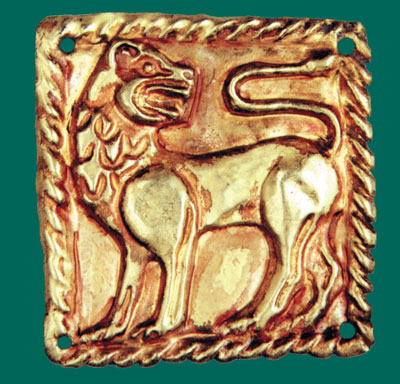 |
509 BC to 337 AD
The Romans conquer Greece and proceed to lop off the heads of many Greek sculptures. Even so, the Romans appreciate the art of Greece and begin to "borrow" their artistic concepts. Large scale works are seen, as are mosaics, fresco paintings and arches.
Medieval Times
373 to 1453 AD After the fall of the Roman Empire, the only stable organization left in Western Europe was the church. It’s influence was felt everywhere, and it gave the medieval period its special character. The church saw that art could be used to inspire and teach its followers. Since most people couldn't read, they had to rely on visual images. A limited number of handwritten books were produced for those few who could read, but the illustrations drawn and painted in these books were intended for the majority of people who couldn't read. The carvings on the facade or front of medieval churches also expressed religious teachings.
After the fall of the Roman Empire, the only stable organization left in Western Europe was the church. It’s influence was felt everywhere, and it gave the medieval period its special character. The church saw that art could be used to inspire and teach its followers. Since most people couldn't read, they had to rely on visual images. A limited number of handwritten books were produced for those few who could read, but the illustrations drawn and painted in these books were intended for the majority of people who couldn't read. The carvings on the facade or front of medieval churches also expressed religious teachings. The task of teaching and spreading the faith belonged to monks. They were dedicated men living together under a strict set of rules in religious communities called Monasteries. There were no printing presses during the medieval period, so all books had to be copied painstakingly by hand. Monks who did this copying were often artists of great skill. They took pride in making beautifully proportioned letters and adding graceful miniature drawings.
ROMANESQUE ART (1000 to 1500 AD)
Miniature drawing and painting in religious manuscripts started in early Christian times and became more
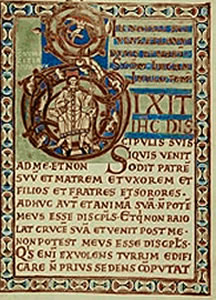 popular during the early medieval period. It continued to be an important artistic activity throughout Western Europe during the Romanesque period. The art of the early medieval period had been local, rarely reaching beyond the surrounding community. Romanesque art, however, gradually became more international in character. This international character resulted from the exchange of ideas due to the growth in trade and travel during the eleventh and twelfth centuries. Romanesque paintings and drawings have a flat, two-dimensional look. Their brightly colored and richly patterned figures and objects look like they were cut from cardboard and laid one on top of the other. Romanesque artists made little effort to make their pictures look realistic. Instead, they used colorful shapes and dark lines to illustrate traditional religious stories. A glance at one of these illustrations quickly brought the story to the viewer's mind. Then the viewer could meditate on the meaning of that story.
popular during the early medieval period. It continued to be an important artistic activity throughout Western Europe during the Romanesque period. The art of the early medieval period had been local, rarely reaching beyond the surrounding community. Romanesque art, however, gradually became more international in character. This international character resulted from the exchange of ideas due to the growth in trade and travel during the eleventh and twelfth centuries. Romanesque paintings and drawings have a flat, two-dimensional look. Their brightly colored and richly patterned figures and objects look like they were cut from cardboard and laid one on top of the other. Romanesque artists made little effort to make their pictures look realistic. Instead, they used colorful shapes and dark lines to illustrate traditional religious stories. A glance at one of these illustrations quickly brought the story to the viewer's mind. Then the viewer could meditate on the meaning of that story.GOTHIC ART (1000 to 1500 AD)
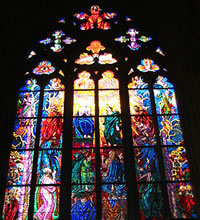 At no other period in history were the visual arts so closely joined in a
At no other period in history were the visual arts so closely joined in a 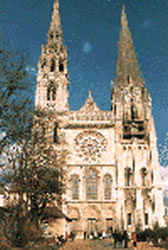 common effort than in the Gothic period. Drawing, painting, sculpture, and architecture were combined to create the Gothic cathedral or church, which featured pointed arches and weight-bearing pillars. Walls were only required to enclose and define space, so artists began designing walls made of stained glass. The designs used for stained glass windows greatly influenced the style of drawing and painting used in manuscript illustrations. Gothic manuscript illustrations often showed slender, graceful religious figures in flowing costumes placed inside frames like those of cathedral windows. Solid gold backgrounds were used to emphasize the spiritual importance of the scenes.
common effort than in the Gothic period. Drawing, painting, sculpture, and architecture were combined to create the Gothic cathedral or church, which featured pointed arches and weight-bearing pillars. Walls were only required to enclose and define space, so artists began designing walls made of stained glass. The designs used for stained glass windows greatly influenced the style of drawing and painting used in manuscript illustrations. Gothic manuscript illustrations often showed slender, graceful religious figures in flowing costumes placed inside frames like those of cathedral windows. Solid gold backgrounds were used to emphasize the spiritual importance of the scenes. Tempera paintings on wooden panels used similar designs to decorate the altars inside churches. This elegant style of painting became so popular throughout Western Europe that it came to be known as the Gothic International style.
 Because the Gothic style of architecture didn't spread to Italy until later, Italian artists could still paint religious pictures on interior church walls. First, the artist made a charcoal drawing on the wall. Then a thin coat of plaster was applied, and the charcoal lines were traced. Paint mixed with water and egg whites was applied. This process gave the painting technique its name, fresco. The paint and wet plaster mixed together to form a permanent surface when they dried.
Because the Gothic style of architecture didn't spread to Italy until later, Italian artists could still paint religious pictures on interior church walls. First, the artist made a charcoal drawing on the wall. Then a thin coat of plaster was applied, and the charcoal lines were traced. Paint mixed with water and egg whites was applied. This process gave the painting technique its name, fresco. The paint and wet plaster mixed together to form a permanent surface when they dried. The painting had to be done quickly while the plaster was still wet. The technique required confidence, boldness, and skill. One extraordinary artist, Giotto di Bondone, had all of these traits. In his Madonna and Child , Giotto captured the love between mother and son.
Renaissance
During the medieval period, people were mainly concerned with living in a way that would assure their eternal reward in the next world. Gradually people became more interested in the present world and their place in it. This change of attitude, the period in which it occurred, and the ways in which it was demonstrated in art, literature, and learning are called the Renaissance.The Renaissance began in Italy during the fourteenth century and reached its peak in the fifteenth and early sixteenth centuries. One reason it began in Italy was that the tradition of classical art and culture was never entirely lost in this country. Studying the classics encouraged artists to look for subject matter outside of religion. It also made realism more important. In drawing and painting, artists developed rules of perspective and the science of using light and dark values to obtain amazingly realistic effects.Up to the Renaissance, the history of art is mainly the history of styles and ideas to which many unknown artists contributed. But after the fifteenth century, the history of art deals mainly with the lives and accomplishments of individual artists. Leonardo, Michelangelo, and Raphael were three artists, who made up the most astonishing trio of geniuses who ever lived at the same time in the same place.
Artists also studied anatomy to try to make their drawings of figures look more life- like. Leonardo da Vinci wanted to learn every thing possible about a subject before trying to recreate it in art. This effort, however, took up so much of his time that the amount of art he finished is rather small. The human body was just one of Leonardo's many interests. He estimated that he filled 120 notebooks with his figure drawings. These drawings were surrounded by explanations and reminders to himself about other subjects that interested him.

|
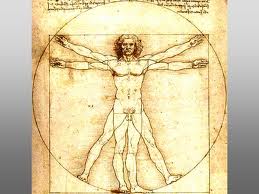 |
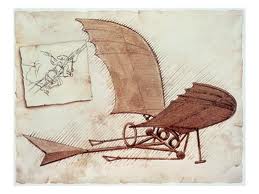 |
| Mona Lisa |
Proportions of man |
Sketch of flying machine |
Michelangelo is known for his painting and sculpture, but he depended on drawing skills to design his works. Imagine that you meet him at the foot of a huge scaffold in the Sistine Chapel over five hundred years ago. The artist peers upward at the dim corner of the ceiling 68' (20 m) above where he will paint a twisting female figure. He reaches for his sketch paper and a piece of red chalk and begins to draw. Then he returns to his small studio. Michelangelo takes out a fresh sheet of paper and begins to draw a model, concentrating on the model's feet, hand, and torso. All of these drawings are crowded onto a single sheet. All of the available space is used because paper is expensive. The artist has been drawing a male model, since female models weren't used in the sixteenth century. So Michelangelo makes another drawing at the bottom corner of the paper, changing the face of the figure to look more like a woman's. Michelangelo is tired. It seems as if the Sistine Chapel ceiling will never be finished. He has food sent up to him on the scaffold, so he doesn't have to stop work. He leaves the scaffold for a few hours of sleep only when he is too weary to continue. Painting the ceiling seems like a waste of effort. The walls in the chapel are already decorated with great works by well-known artists. Who will bother to stop admiring these paintings and look up at the ceiling? Unexpectedly the artist reaches for a pen and begins to write, perhaps to express some of his frustration and disappointment. "When will the nightmare be over? My chin is growing into my stomach, my beard has become part of my arm, my face is a mosaic of color, now I drink and breathe only paint. My body is twisted backward in a circle and my sanity is completely gone. I hate this place. Why am I here? I'm not even a painter!"
The next day Michelangelo would begin drawing and painting the new figure on the ceiling. It would be one of 342 figures he created on the chapel's ceiling. The task demanded all of his waking hours for four years. But as an eyewitness later reported, when the artist was finally finished and the Sistine Chapel was opened to the public, the whole world rushed to Rome to stare in wonder at the ceiling. Michelangelo wanted to keep his creative process a secret. He gathered up and burned as many of his sketches as he could before he died. Only a few survived.
 |
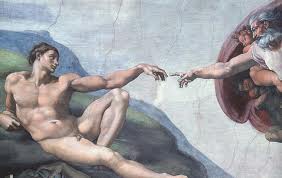 |
 |
| Moses |
Sistine Chapel |
David |
Raphael Sanzio didn't invent new techniques, as Leonardo and Michelangelo did, but he was able to perfect their techniques to create what is referred to as the High Renaissance style. His figures skillfully blended Michelangelo's sense of movement and full, well-rounded forms, and Leonardo's soft modeling with light and dark values. But even though he borrowed freely from these and other artists, Raphael maintained his own identity by adding his own charm and grace. These qualities are especially apparent in The Madonna of the Pinks.
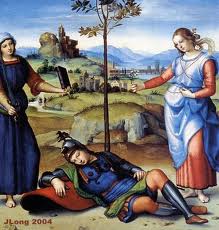 |
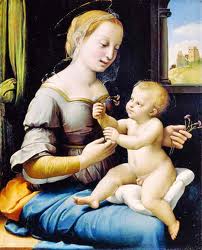 |
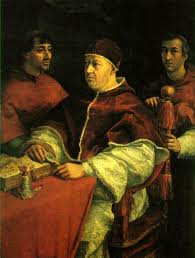 |
| The Knight's Dream |
Madonna of the Pinks |
Pope Leo X with Cardinals |



Sixteenth Century
The artists of the island city of Venice combined the lights and colors reflected in surrounding waters with a Renaissance concern for reality. Their style was noted for its brilliant use of color, light, and texture; its swirling, full-bodied figures; and its dreamlike atmosphere.The first of the great Venetian artists was Giorgione. Although only a few of his pictures still exist, he is regarded as one of the greatest painters in history. His work changed the way people thought about paintings because his paintings weren’t just drawings filled in with color. He put areas of color next to each other without using many lines. When Giorgione died, Titian became the most important Venetian painter. From Giorgione, Titian learned how to use landscape to create moods. Landscapes are works of art that use natural scenery as subject matter. Although he drew and painted every subject you can imagine, Titian was most famous for his skillful portraits of kings, popes, philosophers, and military leaders.
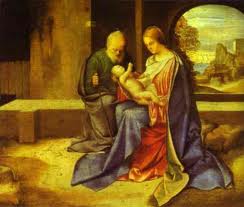 |
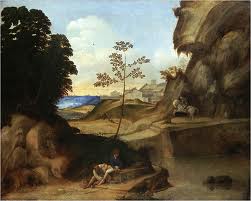 |
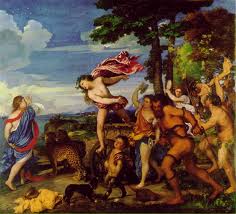 |
| Holy Family Giorgione |
Sunset Landscape Giorgione |
Bacchu & Ariadne Titian |
The last great Venetian artist of the sixteenth century was Tintoretto. Tintoretto’s figure drawings used the same full-bodied form and sense of movement in space as those by Michelangelo. In his paintings, Tintoretto emphasized the emotional aspects of a story rather than illustrating it accurately. His highly unique painting style used contrasting light and dark values to suggest a flickering movement. He stretched out the proportions of figures and often showed them making exaggerated, theatrical gestures. The church welcomed this style of dramatic painting because it was experiencing disorder and change. Martin Luther had started the Protestant Reformation in 1517. Many people were leaving the church. Its leaders valued the art of Tintoretto and others because it appealed to the emotions of the people, reminding them that the church was still there to help them find salvation.
 |
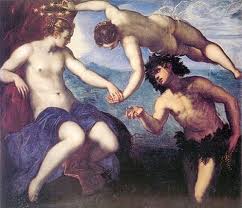 |
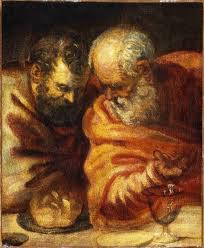 |
| St. George & the Dragon |
Ariadne, Venus & Bacchus |
Two Apostles |
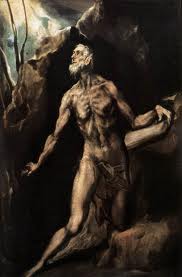 |
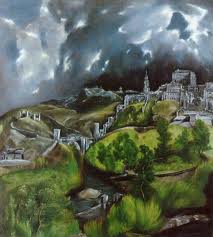 |
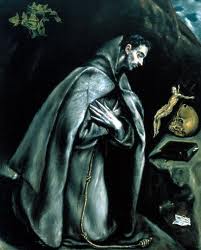 |
| Saint Jerome |
View of Toledo |
Saint Francis |
Seventeenth Century
By the beginning of the seventeenth century, the church had regained much of its influence in Italy and was involved in a large- scale program of building and decoration. A new style of church construction known as Baroque featured a sculptured, dynamic look. The unique character of the Italian Baroque painting style was due largely to the efforts of one man, Caravaggio. Caravaggio was curious about how things actually looked and drew his inspiration from carefully observing things around him. Later, his style changed to include a greater use of a bold, strong light. His figures looked human, not spiritual or supernatural as they did in Mannerist paintings. Caravaggio's style of combining light and realism had an impact on the entire European art world.Perhaps the only Italian artist of this period worthy of being ranked alongside Caravaggio is the Bolognese painter Annibale Carracci. He shared Michelangelo's belief that artistic perfection could only be achieved through drawing. His later works used a line quality powerful enough to be compared with Michelangelo's. But Carracci could also use a firm, clear, sensitive line to create a scene of great warmth and charm
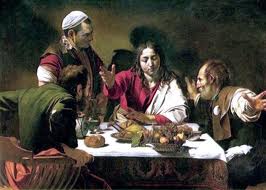 |
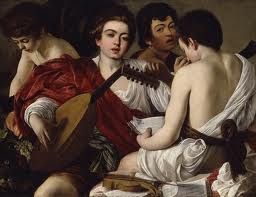 |
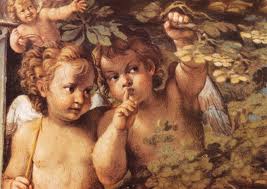 |
| Supper at Emmaus Caravaggio |
Musicians Caravaggio |
Whispering Angels Carracci |
Peter Paul Rubens was the greatest Flemish painter of the seventeenth century. While still a young man, Rubens spent eight years in Rome. The drawings he created at that time show that he studied classical ruins, the works of Renaissance masters, and the works of leading contemporary artists, including Caravaggio. Rubens's later drawings and paintings were noted for their grandeur and flowing rhythm
Anthony van Dyck, Rubens's greatest follower, gained fame as a portrait painter. His fashionable portraits were noted for their elegance, dignity, and skillful portrayal of rich materials. Besides his famous portraits, van Dyck also made some remarkably fresh landscape studies in watercolor and in inkramatic, emotional works of art are made during the Baroque era. Curvy figures, bold self-portraits and genre (images of everyday people) are popular.
Art works
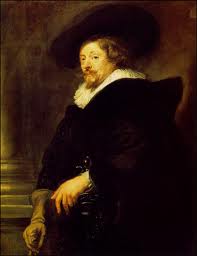 |
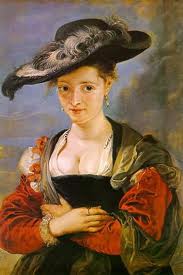 |
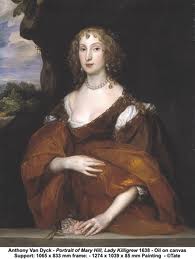 |
| Self Portrait Peter Paul Rubens |
The Straw Hat Peter Paul Rubens |
Portrait of Mary Hill Anthony van Dyck |
Rembrant's Works
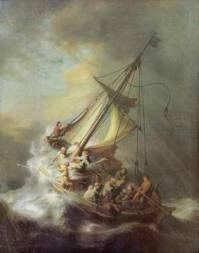 |
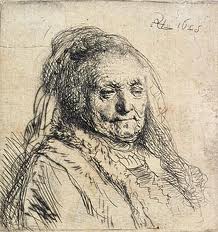 |
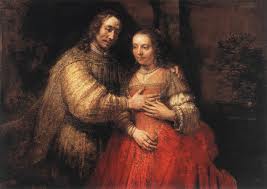 |
| Storm on the Sea of Galilee |
Rembrant's Mother |
The Jewish bride |
Eighteenth Century
1700 to 1750in France, a relaxed and playful art style known as Rococo develops. People dance and sing their way through art.At the beginning of the eighteenth century a new , lighter style of art, inspired by the work of Rubens and the great Venetian masters of the sixteenth century, appeared in northern Europe. This style used a free, graceful movement; a playful application of line; and rich colors. The label attached to this new style is Rococo.
Antoine Watteau, a Fleming by birth, developed the Rococo style to its highest level. His drawings and paintings, a haunting combination of grace and sadness, present a make- believe world in which trouble-free young artistocrats pursue pleasure and romance. Watteau valued his drawings more than his paintings because the drawings had qualities that he couldn't render in paint. Often relying on three colors of chalk, he drew figures with a confidence and delicacy often missing from his paintings .
The man who continued Watteau's style was Jean-Honore Fragonard. Fragonard, like Watteau, was a court painter. Fragonard's gay, romantic subjects were well suited to a painting style that featured delicate color and sound drawing
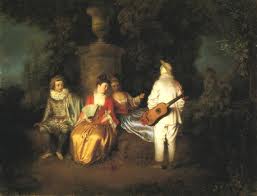 |
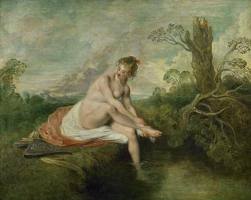 |
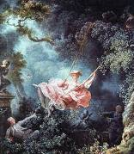 |
| La Partie carrée Antoine Watteau |
Diana at Her Bath Antoine Watteau |
The Swing Jean-Honore Fragonard |
Before the middle of the eighteenth century, the Protestant Reformation had caused hostility to religious art, and not much art was created in England. The artist who was largely responsible for increasing the prestige of English painting was Sir Joshua Reynolds. He was successful in painting the portraits of the aristocracy and became the undisputed leader of his profession.
Thomas Gainsborough was Reynolds's equal as a portrait painter, although Gainsborough maintained that he preferred landscapes. The colors in Gainsborough's paintings sparkle when viewed from a distance. Viewers are surprised when they move closer to discover the sketchiness of his painted surfaces. Gainsborough created this effect by sometimes painting with brushes attached to handles measuring as long as six feet. Using these-enabled him to place himself at the same distance from his model and his canvas.
Another famous eighteenth-century artist was William Hogarth. Many of his paintings were picture stories told in several scenes. They revealed the immoral conditions and foolish customs of his time.
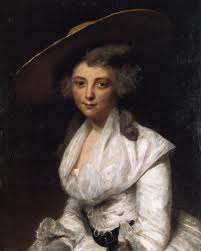 |
 |
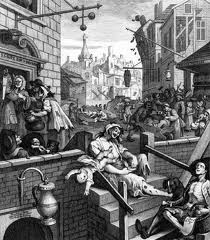 |
| Mary Bingham Sir Joshua Reynolds |
Wooded Moonlight Landscape Thomas Gainsborough |
Gin Lane William Hogarth |
The outstanding Italian artist of the eighteenth century was Giovanni Battista Tiepolo. Constantly commissioned to make paintings, he created ceiling and wall frescoes filled with airborne figures and fleecy clouds. In his studies for these frescoes, he used broad sweeps of light values over the barest suggestion of chalk rendering to suggest three- dimensional forms. Francesco Guardi, brother-in-law of Tiepolo, is the best-known member in a family of Venetian artists. He is famous for his pictures showing various views of Venice. Guardi's drawings are free and expressive. They suggest rather than describe, hint rather than declare.
Canaletto, another Venetian artist, used canals, churches, bridges, and palaces as subjects. As in many of Canaletto's works, the subject is seen from a distance in order to include as much of it as possible. Even though Canaletto didn't communicate much feeling in his work, during his lifetime he was Italy's most popular artist.
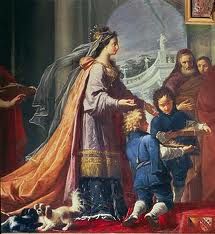 |
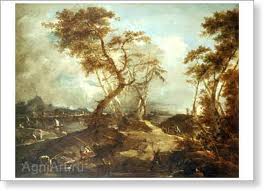 |
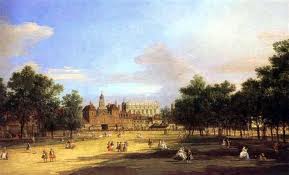 |
| Queen of Sheba Giovanni Battista Tiepolo |
Landscape Francesco Guardi |
Old Horse Guards Canaletto |
1750-1880
Neoclassicism originate in Rome and spreads in reaction to the excesses of Baroque and Rococo. Scenes from Roman history become en vogue and copies of antique art are all the rage. The French Revolution is captured by artists like Jacques Louis David, while across the ocean, colonial American painters put oil to canvas as Neoclassical buildings are constructed. Neoclassicism was a reaction to the earlier Baroque and Rococo styles. Rejecting traditional subject matter, artists turned to the classical art of ancient Greece and Rome and the Renaissance masters for their inspiration.
Among the foremost artists to work in this new Neoclassic style were Jacques-Louis David and Jean A. D. Ingres. Ingres is considered to be one of the great drafters of history. He was forced for a time after the defeat of Napoleon to make a living by drawing pencil portraits of wealthy English tourists. Ingres developed a style marked by a keen eye and sensitivity for line.
Theodore Gericault is usually credited with creating the Romantic style, which emphasized a spontaneous approach to drawing and painting. At Gericault's death, Eugene Delacroix assumed the leadership of the Romantic movement. A trip to north Africa in 1832 exposed him to the colorful life of the Arabs. One of his drawings, showing an Arab being attacked by a lion, clearly illustrates Delacroix's ability to capture furious action. Neoclassic artists such as Ingres and David turned to classical Greek and Roman artists and Renaissance artists for their inspiration.
Art works
 |
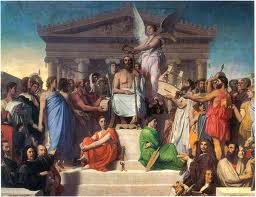 |
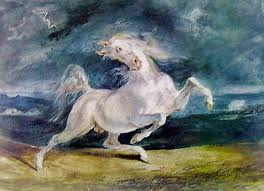 |
| Napoleon Jacques-Louis David |
Jean A. D. Ingres |
Frightened Horse Eugene Delacroix |
Nineteenth Century
1800 to 1880Romanticism a somewhat vague movement involving violent activity, bold brush strokes and rich colors take over.The most significant artist in Spain during this period in history was Francisco Goya. Goya's early works showing the aristocracy at play are similar to Watteau's and Fragonard's paintings done in the Rococo style. But later his style changed dramatically. In a series of etchings entitled Disasters of War, Goya recorded the horrors associated with the invasion of Spain by French troops in 1808 under Napoleon .
Art of Francisco Goya
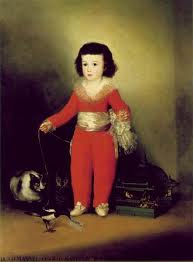 |
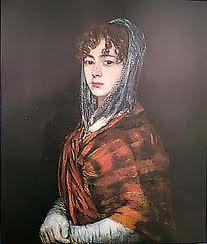 |
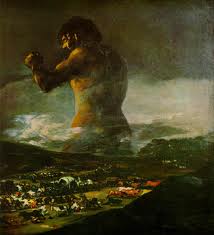 |
| Manuel Osorio | Senora Sabasa Garcia | Colossus |
One of the first artists to use the Realistic style was the caricaturist, painter, and sculptor Honore Daumier Although Daumier may have wanted to create more paintings, poverty forced him to spend much of his time making lithographs for publication. Lithographs are prints made from inked stones or metal plates. Many of the four thousand he produced criticized the social and moral injustices of his age. Daumier's drawings show us that he was one of the great drafters of all time.
Gustave Courbet was the acknowledged leader of the Realist movement in France. Courbet believed that artists should use direct experience and paint only what they had seen and understood.
 |
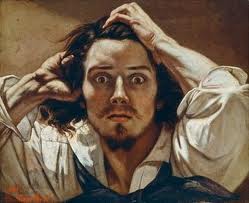 |
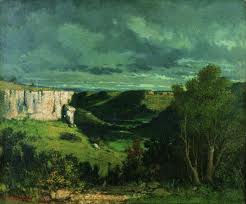 |
| Third Class Carriage Honore Daumier |
Desperate Man Gustave Courbet |
Valley of Love Gustave Courbet |
Since he exhibited his paintings with Courbet's, Edouard Manet was considered to be a part of the Realist movement. His work, however, is actually a bridge between Realism and the art movement that followed, Impressionism. Much of Manet's work was inspired by his study of the old masters, including Raphael, Giorgione, Titian, Velazquez, and Hals.
 |
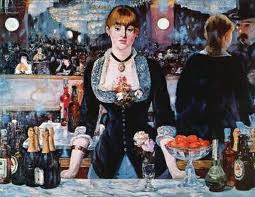 |
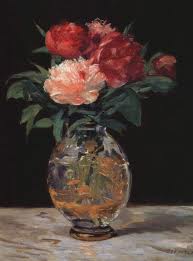 |
| Boating |
Bar Maid |
Bouquet of Peonies |
Artists who reject academic painting band together. they create works of art which depict the effects that light has when it falls on objects in the great outdoors, Impressionism is born and the greatest art movement since the renaissance is in full swing. Using the contemporary scene, as Courbet and Manet did, the Impressionists tried to reproduce an impression of what the eye sees at a specific moment in time - not what the mind knows is there. They were attracted most often to the landscape, with or without people.
The best known of the Impressionists was Claude Monet. Working outdoors, Monet became fascinated by constantly changing colors. He often painted the same subject under different light conditions.
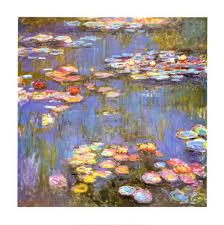 |
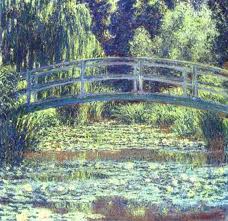 |
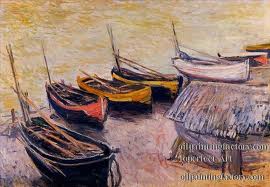 |
| Waterlilies |
Japanese Footbridge |
Boats on the Beach |
Auguste Renoir, another Impressionist, carefully arranged his compositions. His subjects were posed to look as if the viewer had encountered them accidentally. His works show a love of warm colors, appealing subjects, and sun-drenched landscapes.
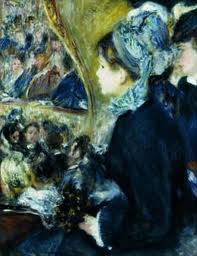 |
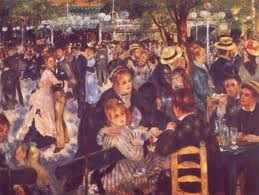 |
 |
| At the Teater |
Ball at the Moulin de la Galette |
Roses |
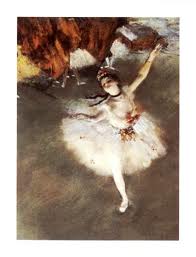 |
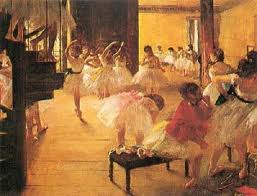 |
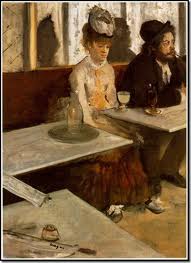 |
| Ballerina |
Ballet School |
In the Cafe |
Georges Seurat developed a style of art known as Neo-Impressionism or Pointiliism. He deliberately applied tiny, uniform dots of pure color to his canvases instead of using a more uneven color pattern of dabs and dashes. Seurat was also a splendid drafter. He is noted for drawings done in black conte crayon

|
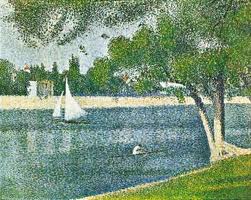 |
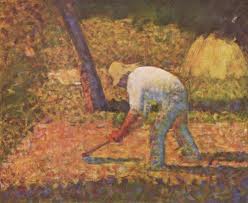 |
| Un dimanche après-midi à l'Île de la Grande Jatte | Sunday afternoon on La Grande Jatte.jpg |
Farmer with ax |
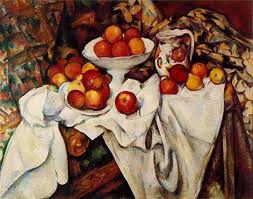 |
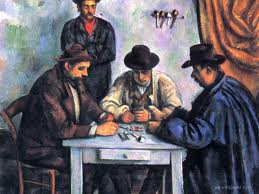 |
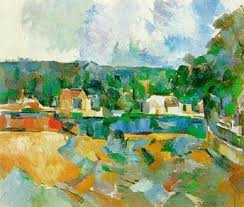 |
| Apples & Oranges |
Card Players |
Landscape |
 |
 |
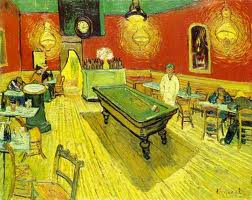 |
| Starry Night |
Sunflowers |
Night Cafe |
 |
 |
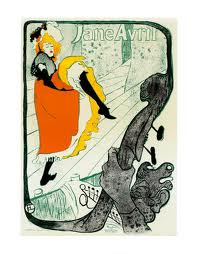 |
| Divan Japonais |
At the Moulin Rouge |
Jane Avril |
 |
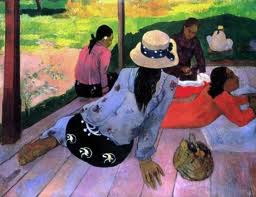 |
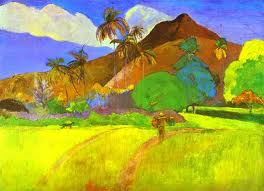 |
| Cat |
Siesta |
Tahitian Landscape |
Twentieth Century
Art critic Roger Fry coins the term Post-Impressionism that is used to describe the work of artists with a freely expressive use of color and form. Soon after the Expressionists become interested in the depiction of emotions and the types of response those same emotions evoke. vibrant colors and a fascination with primitive art are very important. At the same time, artists known as wild beasts are part of a movement called Fauvism.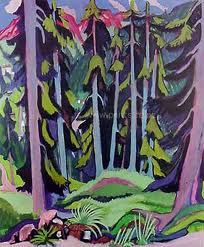 |
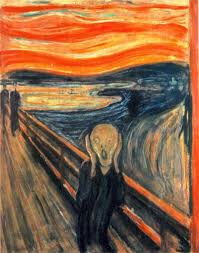 |
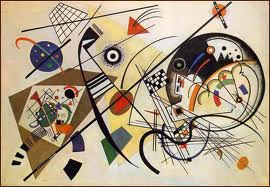 |
| Forest with Brook Ernst Kirchner |
The Scream Edvard Munch |
Grandfathers & Influences Wassily Kanlinsky |
Fauvism was the first major modern art movement of the late 19th and early 20th century and although not a movement of longstanding it was a style that was to influence many artists in Europe and throughout the world. The word Fauvism comes from the French word 'fauve' which means 'wild animals’ and indeed this new modern art style was thought a bit wild with its strong vivid colors. Fauvists rejected the soft tone colours of the Impressionists and the dainty stroke applications of the Neo-Impressionists and were in favour of applying bold untouched colours to their canvases in broad rough strokes that on many occasions would distort their subject. The principles of Fauvism permitted the artists the freedom to think outside of the traditional academic structure, and by allowing the artists the luxury of freethinking they were able to create paintings of interpretations instead of an imitation of the actual subject matter. Henri Matisse was the founding father of Fauvism.
Art works of Henri Matisse
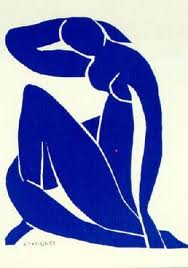 |
 |
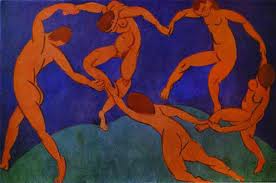 |
| Blue Nude |
Michaela |
The Dance |
Two unique landscape painters, John Constable and J. M. W. Turner, charted the direction that art was to take in England.
John Constable tried to create a feeling of the momentary, a glimpse of nature at a particular moment. For this reason he focused attention on color, light, and atmosphere. For Constable, the sky with its moving clouds was the focal point of any landscape. Working outdoors, Constable completed countless sketches of the English countryside which were the basis for his large, six-foot wide paintings.
Art works of John Constable
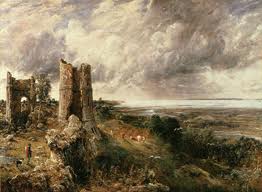 |
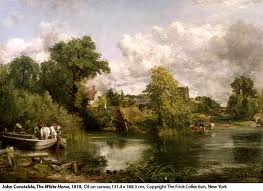 |
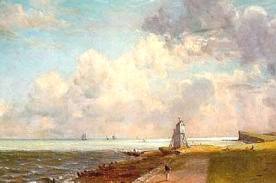 |
| Hadleigh Castle |
The White Horse |
Harwich Lighthouse |
Joseph Mallord William Turner is regarded as one of the most original landscape painters. Like Constable, he was fascinated by light and atmosphere. But he combined this fascination with an active imagination. In his paintings, the forms seem to dissolve in the golden glow of light.On his many travels, Turner filled sketch - books with studies of every kind. Space and light dominate in his pencil drawing of the Scottish highlands In this drawing you can see the barest hint of a landscape beyond the darker figures of herdsmen and their livestock.
Art Works of Joseph William Turner
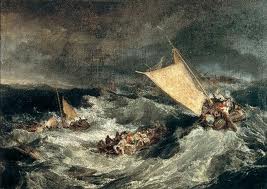 |
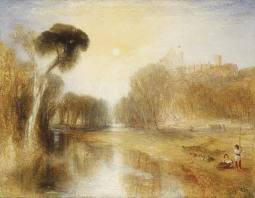 |
 |
| Shipwreck |
Rosenau |
Popes Villa |
By the close of the nineteenth century, the United States had become a world leader. The country’s change and growth were reflected in American art. The art of this period is best represented by the works of three artists— Winslow Homer, Albert Pinkham Ryder, and Thomas Eakins.
Homer’s work reflects his lifelong affection for saltwater, ships, and sailors. He was largely self-taught and worked for many years as a lithographer before directing his energies to serious painting. Often his pictures show man opposing the powerful forces of nature.
Art works of Winslow Homer
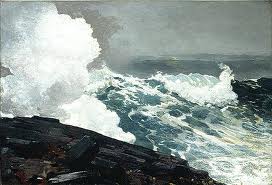 |
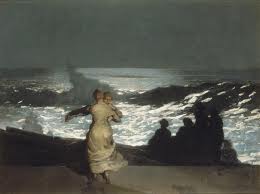 |
 |
| Northeaster |
Summer Night |
Rowboat |
Albert Pinkham Ryder’s small paintings show that he ignored technique. He layered on paint to thicknesses of one-quarter inch and often returned to work on a picture while it was still wet. As a result, his paintings have cracked and faded with age. Even so, Ryder achieved a position as one of the dominant American painters. His imaginary subjects were painted in a simple style using large areas of color and texture.
Art Work of Albert Pinkham Ryder
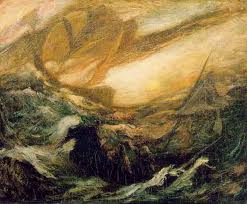 |
 |
 |
| Flying Dutchman |
Dead Bird |
Toilers of the Sea |
Thomas Eakins valued precision and accuracy so much that when he was painting a crucifixion he strapped a friend to a cross for a model. When drawing or painting a surgical operation, Eakins didn’t try to soften the impact of the scene. Works showing such harsh subjects in such startling detail were often excluded from exhibitions.
Art Works of Thomas Eakins
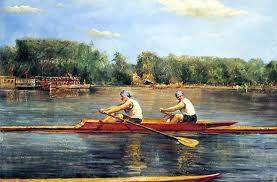 |
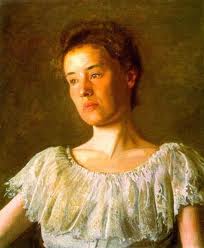 |
 |
| Biglin Brothers Racing |
Alice Kurtz Eakins |
Surgery |
Pablo Picasso and George Braque come together to create Cubism. Images on canvas are reduced to cube-like shapes and 'flimsy sculpture' or collages appear.
Art works of Pablo Picasso
 |
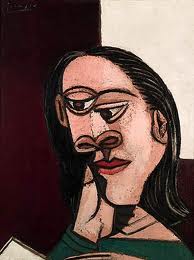 |
 |
| Guitar Player |
Dora Maar |
Three Musicans |
Art works of George Braque
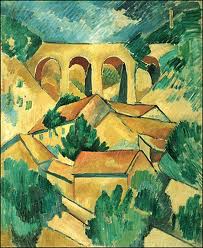 |
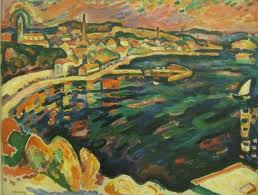 |
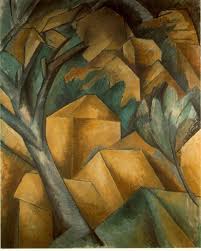 |
| Viaduct |
Harbour |
Housesle |
The story of the Group of Seven Artists began in the early 1900s when several Canadian Artists began noticing a similarity in style. Around 1912 a loosely knit group of artists began to paint Canada as they saw it. Sketch boxes in tow, they journeyed all over the country to paint the wilderness with bold colors and a broad, decorative style. Despite the death of mentor Tom Thomson in 1917, these painters banded together as the Group of Seven in 1920 to forge a new Canadian expression. Their vision shaped how Canadians saw their own country and left a legacy that continues to provoke debate and discussion. In 1920, the group put on their first exhibit and formerly called themselves the Group of Seven. The artists included were J.E.H. MacDonald, Franklin Carmichael, Frank Johnston, Arthur Lismer, Lawren S. Harris, Frederick Varley and A.Y. Jackson. They are historically recognized as the first group of European descent to capture the feel of the Arctic on canvas.
Art Works of the Group of Seven
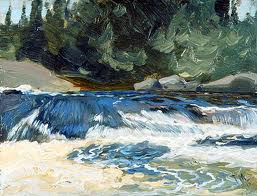 |
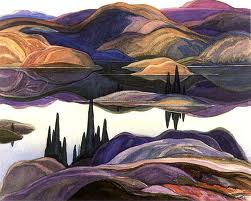 |
 |
| Spring Rapids J.E.H. MacDonald |
Mirror Lake Franklin Carmichael |
Winter Frank Johnston |
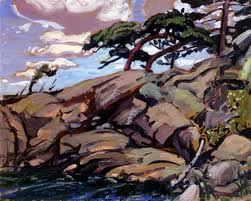 |
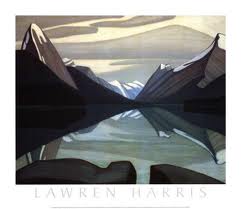 |
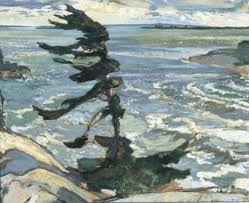 |
| Moon River Arthur Lismer |
Maligne Lake Lawren S. Harris |
Stormy Weather Frederick Varley |
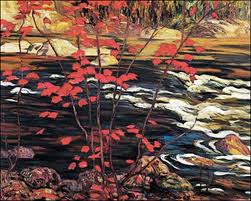 |
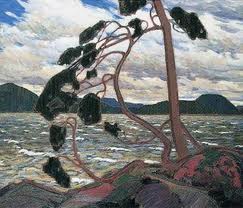 |
Tom Thomson died before the formation of the Group, but often included as an Original Member |
| Red Maple A.Y. Jackson |
West Wind Tom Thomson |
A French word meaning hobbyhorse is the nonsensical name given to a nonsensical movement called Dada. everyday objects like urinals, are signed and called art.
Art Works of the Dada Movement
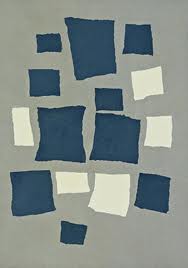 |
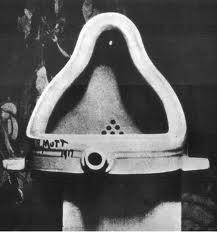 |
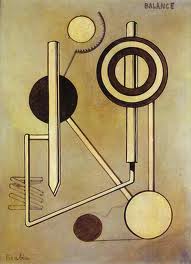 |
| ?? Jean Arp |
Balance Francis Picabia |
An influential German school of design headed up by architect Walter Gropius, the Bauhaus applied some of the concepts of cubism to architecture and art. In North America, an unprecedented outburst of creative activity among African Americans occurs.
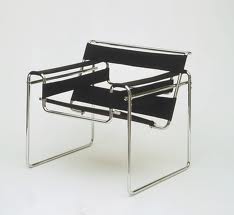 |
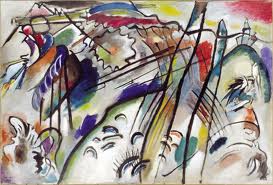 |
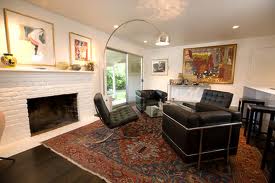 |
Dreamlike states make way for Surrealism as artists share an upbeat fascination with the strange. Watches melt, apples replace heads and fun is had by all. Salvador Dali made important contributions.
Art works of Salvador Dali
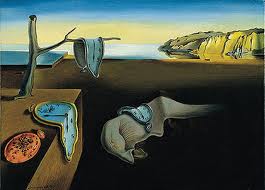 |
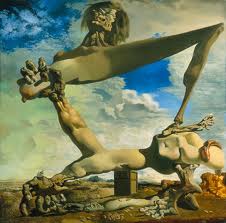 |
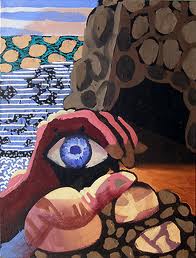 |
| Persistence of Memory |
Soft Construction |
Eye |
Beginning in New York city, abstract Expressionism marks the end of recognizable subject matter. Self-discovery and the sense that one can do or say anything is what life is all about as the artistic center of the wold shifts from Paris to New York. Drip paintings and canvases covered with just one color are a common sight.
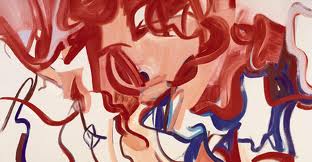 |
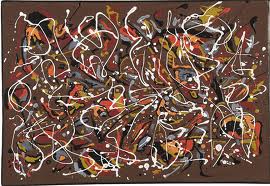 |
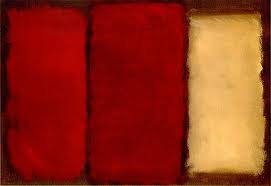 |
| Willem de Kooning |
Jackson Pollock |
Mark Rothko |
Optical illusions appear in art galleries as Op Art takes a bow. Meanwhile, image of popular culture show up here, there, and everywhere as Pop Art turns heads.
Op Art
 |
 |
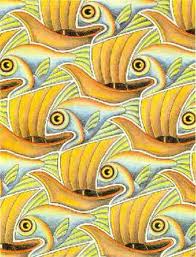 |
Pop Art - Andy Warhol
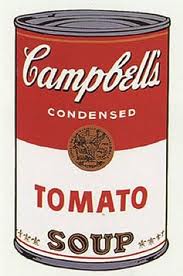 |
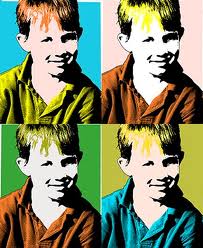 |
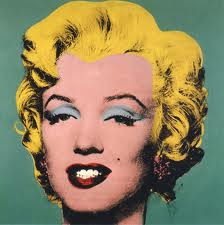 |
After all the hoopla, Minimalism is the way to go. Art is reduced to the simplest of elements and what you see is what you get.
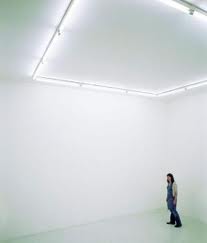 |
 |
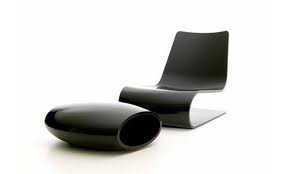 |
Artists experiment with various concepts including wrapping things up with fabric, tinkering on computers and dancing their way through art shows. shock value becomes more and more important as creative souls wait to see who will start the next art movement.